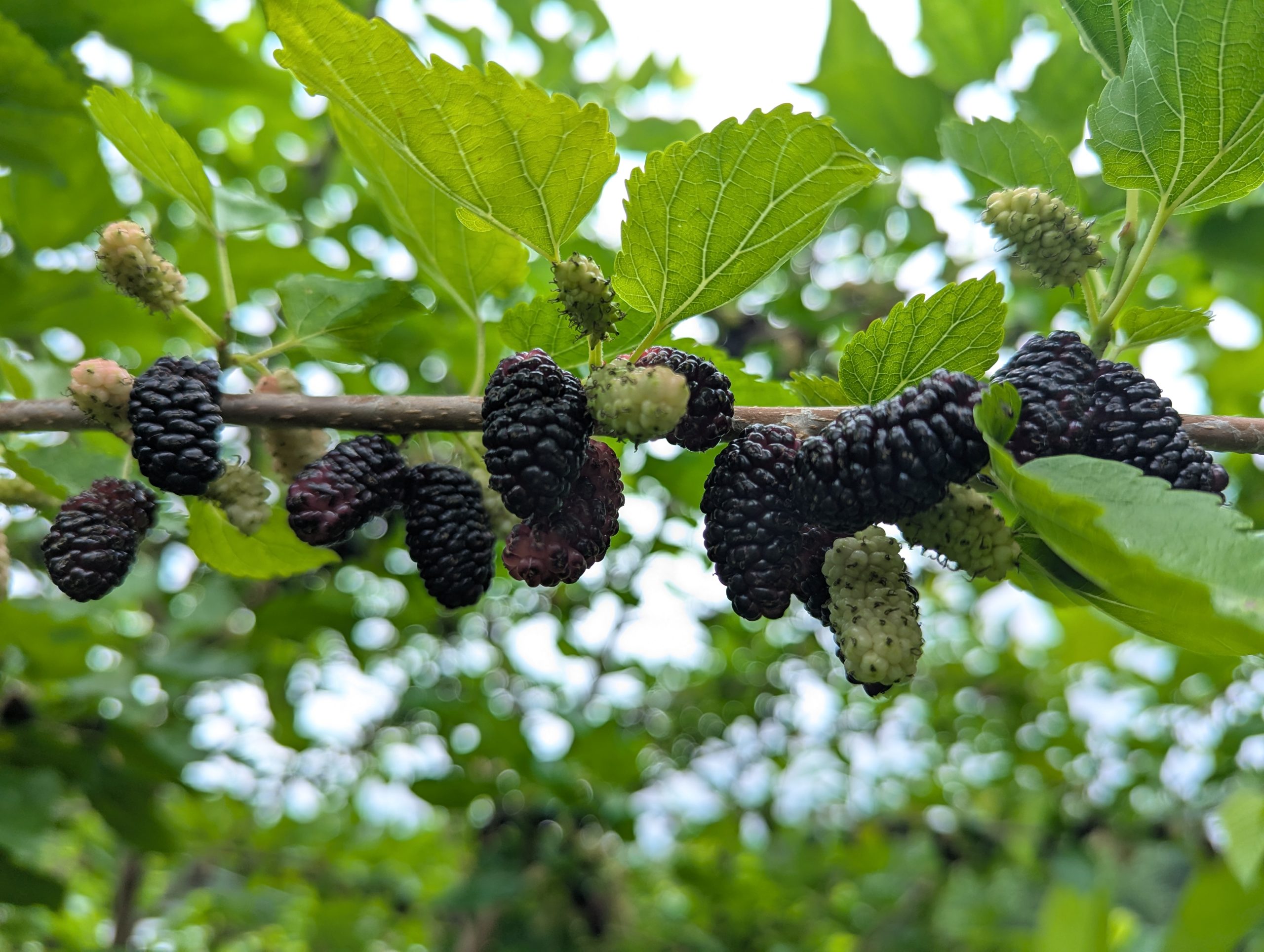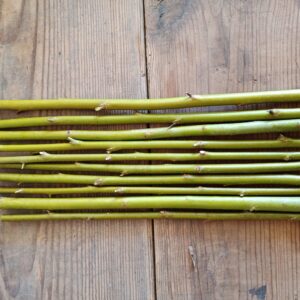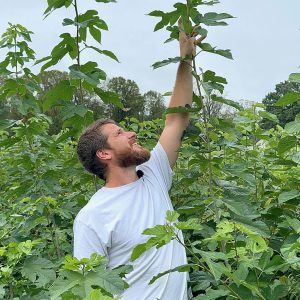I don’t know why it took me so long to put these pieces together, but I finally did the math on how much it would cost to feed pigs and poultry on tree crops, and it’s a game changer. Even that term undersells it. This is nothing short of revolutionary.
I’ll start by acknowledging that data on the production of tree crops is fairly sparse. It also varies widely from one context to another, so take everything here with a grain of salt and use your best judgment to apply this to your own context. While chestnuts, persimmons and apples have published yield data, mulberries have practically none, so we need to look to anecdotes to estimate yield. The main source of those anecdotes is the book Tree Crops by J. Russell Smith. In this 1929 book, Smith shares how people used tree crops in the early 20th century for human food as well as livestock feed. But it’s the livestock feed that we’re most interested in here.
Let’s start with the most conservative anecdote that Smith shares in his book and break down the math on the cost of providing feed via planting trees.
“Mr. R. H. Ricks, a farmer specializing in cottonseed at Rocky Mount, North Carolina, gives the following testimony: “I planted two hundred mulberry trees of the everbearing variety thirty-three years ago on what I regarded as waste land. They commenced having some fruit at once, but they did not have profitable crops until the fifth year. I have since planted another orchard of fifty trees. I carry fifty to sixty hogs on the fruit ten to thirteen weeks every year for the last twenty-seven years without other food, and in the main bearing season the two hundred and fifty trees would carry twice the number of hogs. Nearly every farmer has a small orchard in this section, eastern Carolina. I regard the mulberry for hog food with much favor.”
While this farmer may not have exact data on how many pounds of mulberries came from each tree, he does know how many trees he has, how many pigs he’s raised, and has been doing it for decades now. I have more confidence in that than in many university trials.
So if we estimate that this farm could carry an average of 75 pigs (50-60 during the full growing season, and double during the peak season) for 11 weeks or 77 days, and that each pig was consuming the mulberry equivalent of a conservative 4 pounds of grain daily (a 150-pound pig should be expected to eat more than 5-lbs of feed daily), you can estimate that the orchard produced the equivalent of 23,100 lbs of grain feed over the course of the season. That’s 92.4 pounds per tree, every year once they hit some maturity.
Let’s assume the cost of establishing that tree was $50 and you got a 20 year loan at 6% interest to cashflow the purchase, giving you a total repayment amount of $85.92 or $4.30 annually. Let’s also recognize that for the first several years you have little to no yield, and that you only get 15 years worth of yield in the first 20, or 1,386 lbs. That gives you a grand total of $0.06 per pound of feed over those 20 years. Read that again, and no, I didn’t put the decimal point in the wrong spot. That’s 6¢ per pound. And this is on low-quality, ‘waste ground’.
In a world where pastured pig and poultry producers are paying several times what their confinement counterparts pay for feed, 6¢ per pound is nothing short of revolutionary. That means the cost of feed can be significantly less for pasture-based producers than even CAFO operations! For feed that is organic, non-GMO, corn-free and soy-free. It’s the most premium feed at a fraction of the cost of the cheapest feed available! And after the loan term, the rest is completely free. It’s an investment in critical farm infrastructure that, rather than deteriorating like a barn, only gets better and better for generations to come. And that’s not even the best scenario.
Next let’s look at a more representative sample, a rule of thumb that is mentioned several times in Tree Crops: one mulberry tree could support one hog over the course of 3 months. In that case we’re talking 4 pounds of feed daily over 90 days, or 360 pounds of feed equivalent from a single tree. When you divide an annual payment of $4.30 by 360 pounds, you get $0.012 per pound of feed. That’s not 12¢. That’s 1.2¢! A rounding error over a penny! And Smith shares testimonials from many farmers who considered it typical that an older tree could support multiple hogs during the drop season. So our example doesn’t even represent the upper limit of feed production from mulberry trees and the lowest feed cost possible.
Not convinced? Let’s go to other tree crops where more recent data exists.
While we have very little data on the yield of American persimmons, this industry report states that farms growing Asian persimmons get an average of 6.95 tons per acre annually, which happens to line up well with observations found in Tree Crops. Let’s go with 6 tons (12,000 lbs) of fresh fruit to be conservative. Fresh American persimmons are about 65% water, so we need to compare those to corn, which is stored at only 15% water. That gets you an equivalent of 4,941lbs of corn. American persimmon trees have fairly narrow crowns, so you’d probably need 50 trees to provide light shade on an acre, so let’s call it a nice round 100 pounds of corn equivalent per tree. Using our previous figure for annual payments gives us a cost of $0.043/pound. Again, that’s not 43¢, but rather 4.3¢.
Lastly, let’s look at chestnuts, a carbohydrate-rich crop for pigs and turkeys as well as ruminants. Red Fern Farm is based in Iowa and has great experience growing chestnuts. They state that you “should be able to produce 3,500 to 4,000 lbs per acre”. Let’s be conservative and estimate 3,000 lbs for a low-input silvopasture operation. Fresh chestnuts are about 45% water, so they are equivalent to 1,941 pounds of corn. Chestnuts grow wider than persimmons and similar to a mulberry, so let’s estimate we have 35 of those per acre, giving us 55.5 pounds per tree. When you divide the annual payment of $4.30 by 55.5 pounds, you get $0.077, or 7.7¢ per pound.
Doing the numbers like this blew my mind, even though I’ve been looking into these tree crops reports for years. I’m still trying to unravel how this reality is likely to reshape the growing of pigs and poultry on pasture. What is clear is that this presents an amazing opportunity, an actual competitive advantage for those raising livestock on pasture. There’s basically no way to raise livestock for less than CAFOs do if you’re feeding grain on pasture, because the CAFOs are always buying in the largest bulk. But tree crops flips the tables so that those raising animals on pasture have the chance to be the highest quality and the low-cost option! Please let that sink in, because it’s the opposite of what we’re used to thinking is even possible, and has the power to transform the basic rules of how pigs and poultry are raised. It’s going to take time, because we’re talking trees. Plantings will need to be cashflowed. Adoption will need to be done strategically. But what an opportunity that lays ahead of people who are paying attention and willing to be patient.
Here’s one way to get some early wins: Rather than thinking about a silvopasture system as needing to have an even amount of feed being produced at different times of the year, like enough mulberries in the summer, then persimmons, apples, chestnuts and acorns in the fall, which is tough to balance and will take a long time for the slower-growing species to come online, we can start heavy on mulberries and have seasonal mulberry finishing operations. Mulberries are cheaper, grow faster, and yield more abundantly than any other tree crop for pigs and poultry. That’s where you’ll get the best ROI, the best early wins.
If I wasn’t already running TFG and wanted to start a farm, here’s what I’d do: Find a spot in the southern US with a long growing season. Plant dozens of acres with a mix of dwarf everbearing mulberries and other, taller mulberries, so I get real yield from the quick-maturing dwarfs in just a few years, and larger per-tree yields from the standard tall trees after that. In a few years, once the trees start yielding enough to make it worthwhile, I’d start to raise poultry and finish them on mulberries, since I could finish them within the drop window for the fruits. I’d develop a brand around these with the best PR in the country, showing off birds foraging below trees and shrubs in every post. It would be a product that justifies premium pricing, but I’ll have paid a fraction of the standard feed cost most people have. As the trees mature, I might integrate pigs, and I’ll add slower-growing trees over time like persimmons and chestnuts so I can produce persimmon-finished pork or chestnut-finished turkey, all the while finishing animals on mulberries. Over time, I might find I have enough production throughout the seasons to go farrow-to-finish, or at least keep younger stock around for 6 months or so. But the mulberries will have gotten my foot in the door and established early profitability.
This is why I started Trees For Graziers. I wanted to shift the landscape of how food is produced, how animals are raised, how landscapes are cared for, and how people can make good, dependable and honest livings while taking care of the land and producing abundance. Now that I’ve finally crunched these numbers, that future seems more and more realistic, and a whole lot closer.




